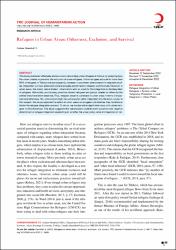Refugees in urban areas: Otherness, exclusion, and survival
Künye
Demirkol, A. (2023). Refugees in urban areas: otherness, exclusion, and survival. TRC Journal of Humanitarian Action, 2, 65-77. https://doi.org/10.55280/trcjha.2022.2.1.0008Özet
This study examined otherness and exclusion concerning urban refugees in Türkiye by analyzing how the urban creates or prevents the exclusion of urban refugees. Urban refugees account for more than 90% of refugees in Türkiye and consequently, represent a prominent phenomenon in migration studies. Integration is a two-sided and bilateral process performed by refugees and the state. However, in urban areas, the state’s role is limited. Urbanization acts as a tool for the integration or disintegration of refugees. Historically, exclusionary practices toward refugees and groups labeled as others by the settled ones have been observed. Thus, refugees become vulnerable in urban areas in terms of exclusion and otherness. Yet, urbanization might be a chance for better integration into the local culture. In this respect, this study explored the effect of urban areas on refugees and whether they facilitate or hinder the refugee integration process. To do so, we conducted in-depth interviews with urban refugees in Afyonkarahisar. This study suggests that urbanization could be both a positive and negative determinant of refugee integration depending on whether the urban policy aims at integration or not.
Kaynak
TRC Journal of Humanitarian ActionCilt
2Sayı
1Bağlantı
https://trcjha.com/article/refugees-in-urban-areas-otherness-exclusion-and-survival/https://hdl.handle.net/11630/11394
Koleksiyonlar
- Makaleler [18]



















